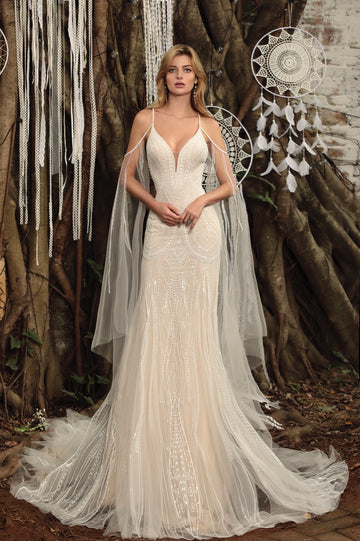How to Navigate Wedding Dress Alterations with Draped Front Details
How to Navigate Wedding Dress Alterations with Draped Front Details
The Importance of Proper Alterations for Your Dream Wedding Dress
Your wedding dress is not just a piece of clothing; it’s a symbol of your love and a cornerstone of your special day. When it comes to bridal attire, how do you handle alterations for a wedding dress with a draped front detail? Proper alterations can make a world of difference, especially when intricate details like draping are involved. In this article, we will explore everything you need to know about alterations for a wedding dress featuring a draped front, ensuring you look and feel your best on your wedding day.
Understanding Draped Front Details
Draped front details add an element of sophistication and elegance to Wedding dresses. They can range from soft, flowing layers to structured folds that draw attention to the waistline. When planning for alterations, understanding the design and how it fits your body shape is crucial.
Why Alterations Are Necessary
Even if you choose a dress that appears perfect off the rack, alterations are often necessary due to factors like:
- Body Shape Variations: Every bride has a unique body shape that may not align perfectly with commercial sizing.
- Dress Style: Dresses with complex designs, like draped fronts, may require precise fitting to ensure the draping falls elegantly and flatters your figure.
- Comfort and Mobility: You’ll want to be able to move freely on your wedding day, so alterations can enhance comfort, especially around the bust and hips.
Steps to Take Before Alterations
Before you begin the alteration process for your draped front wedding dress, consider the following steps:
- Choose the Right Tailor: Finding a skilled tailor who specializes in Wedding dresses is essential. Look for reviews or ask for recommendations from friends who have recently been married.
- Schedule Alteration Appointments Early: Aim to schedule your alterations at least two to three months before your wedding day. This allows ample time for multiple fittings, particularly for dresses with complex details.
- Bring the Right Undergarments: When going for alterations, wear the undergarments you plan to use on your wedding day. This ensures the tailor can accurately fit the dress.
- Prepare a Budget: Alterations can range significantly in price. It’s a good idea to ask your tailor for an estimate upfront, keeping in mind that intricate designs may cost more to adjust.
Common Alterations for Draped Wedding dresses
When it comes to dresses with draped front details, the following alterations are commonly requested:
| Type of Alteration | Description | Impact on Dress |
| Hemming | Adjusting the length of the dress to meet your height. | Can enhance the flow of the draping. |
| Waist Adjustment | Taking in or letting out the waistline. | Ensures proper fit without disrupting the front details. |
| Shoulder Straps | Adjusting shoulder straps for proper support. | Improves overall comfort and presentation of draping. |
| Adding Boning | Inserting boning to provide structure. | Aids in keeping the draped front in place. |
| Reshaping Drapes | Adjusting the drapes for better flow and alignment. | Enhances the visual appeal of the dress. |
Tips for a Successful Alteration Process
To ensure your alterations go smoothly, keep these tips in mind:
- Maintain Open Communication: Be clear about what you want and express any concerns you have during fittings.
- Try the Dress on Multiple Times: Always try the dress on at various stages of alteration to ensure everything is progressing as desired.
- Take Pictures: Capture images during fittings for your reference and to track changes.
- Stay True to Your Style: While alterations can enhance your dress, ensure the modifications align with your vision for your wedding attire.
Addressing Potential Concerns
Worried about how alterations will impact the overall look of your dress? Here are a few common concerns brides express, along with solutions:
- Concern: Will the draped front lose its shape after alterations?
- Solution: A skilled tailor will maintain the integrity of the design while fitting the dress for your body shape.
- Concern: How do I ensure the hem doesn’t disrupt the drape?
- Solution: Communicate clearly with your tailor about maintaining the draping during hemming.
Choosing the Right Time for Alterations
Timing can be everything when it comes to dress alterations. Here’s a timeline to follow:
- 8-12 Months Before the Wedding: Purchase your wedding dress and begin researching tailors.
- 2-3 Months Before: Schedule your first fitting. This is when you should also be ready to address any major concerns with fit and design.
- 1 Month Before: Final fittings should occur here, where any last-minute adjustments can be made.

Conclusion
Handling alterations for a wedding dress with a draped front detail can be a daunting task, but equipping yourself with knowledge and preparation can make the process much smoother. Aim to choose a reputable tailor, maintain open communication, and always prioritize your comfort and style. After all, your wedding day should be about celebrating love, not stressing over your attire. Remember, the goal is to ensure that you shine in your beautiful dress, showcasing the elegance of its design while feeling confident and comfortable. Happy planning!
